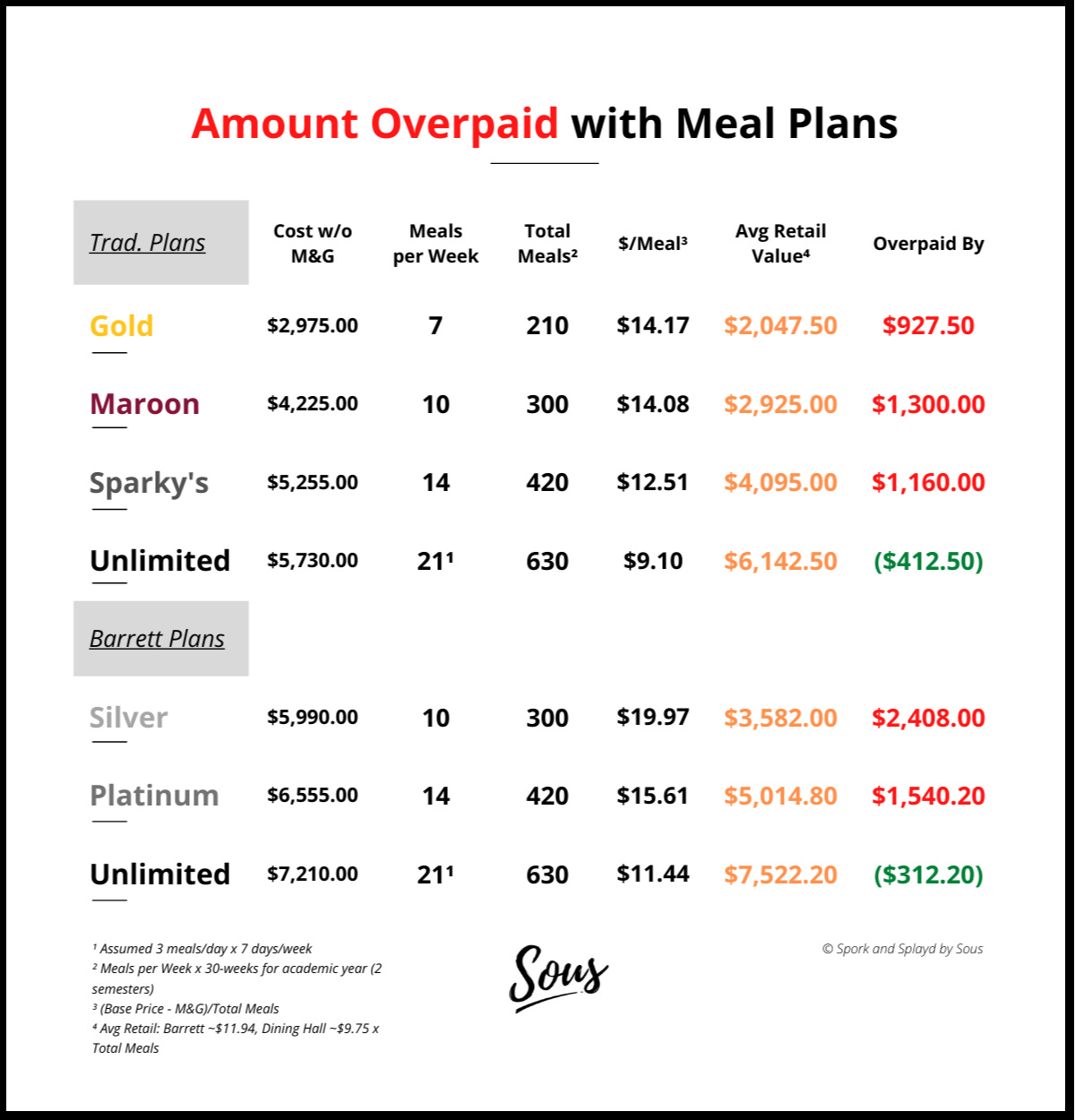True Costs of ASU Meal Plans
If you buy an ASU Meal Plan, you'll be losing money and overpaying.

Congratulations! You've selected Arizona State as your university! You’re an incoming freshman trying to get things squared away before the semester starts.
But like most universities these days, there are many costs that are difficult to get a grasp on.
“What meal plan do I pick? How does it work? Do I choose the Gold or Silver Plans? Is unlimited worth it?”
If those questions popped into your head, then this post is for you.
If you are or your student is a:
first-year freshmen living on the Tempe, Downtown Phoenix, West, or Polytechnic campus
student living in the Barrett Residential Complex
student living in a traditional residence hall
Then ASU (like other universities) forces you to buy a meal plan.
If you already know about the costs, then check out this post:
Otherwise, let’s talk about the breakdown.
Cost Breakdown
These are the new price increases that start applying in the fall, for the 2022-2023 school year. 1
Most of the meal plans have pre-determined “meals” or “swipes” that act as credits towards a meal or a session at a dining hall. Meal plans are sold as “buffet-style” and “all-you-can-eat.”
This seems like a good deal…at first. But the meal plans are misleading.
Here’s why.
You’re Overpaying
You’d think you’d save money as a student by buying a whole meal plan upfront and using meal “swipes” from a meal plan.
Wrong.
If you had just paid out-of-pocket, you’d be saving money.
These are the retail rates per meal (2021-2022):
Average: $11.94
Breakfast $10, Lunch $12, Dinner $13.75, Sunday Brunch $12
Average: $9.75
Breakfast $8, Lunch $10, Dinner $11, Sunday Brunch $10.
Turns out, if you have any plan other than unlimited, eating in dining halls is MORE EXPENSIVE.
How Much Am I Overpaying?
Great question. Here’s the breakdown:
Meal Plans are “Use It or Lose It”
Not only are you overpaying but you could lose money from both meals themselves and the bonus Maroon & Gold dollars (M&G) you receive.
Maroon & Gold Dollars (M&G)
M&G is straightforward. It’s like a “pre-paid” debit card, except for two key distinctions:
You can only use it for on-campus dining locations, nowhere else.
Any leftover M&G is voided before the beginning of the next academic year, meaning you lose the money (unless you purchase it separately)
M&G is more straightforward than meals so you should have no problem fully utilizing it, however, you’ll likely still be overpaying for food and if you don’t use it, you lose it.
Unused Meals
You’re given a certain amount of meal swipes per week.
However, if you don’t use all of your allotted “meals” a week, the ones that are unused become voided. The meals “reset” every week, on Thursday.
You can no longer use them.
They don’t “roll over” to the following week.
Suppose you’re on the “Barrett Silver” plan (10 meals per week). And for some reason, up until Wednesday, you only used 7 meals that week (parents are in town, eating out, traveling, etc.)
Well, by Thursday morning, you will have lost ~$60 (3 meals x $19.98 per meal).
In fact, if you buy a university meal plan right now, you’re set to lose about a third of your money (males: ~28%, females: ~38%). 2 3 4
“Meal plan participation rate is 60-70 percent, meaning that it is expected that students will not use all of their meals. ‘Pricing is determined based on expected usage’—Jim Histand, The Record
Students simply don’t use all their meal plans and university food suppliers know that.
By forcing you to buy a meal plan and preventing meals from rolling over, they profit. You lose money.
How Much Am I Losing?
Universities love your money. Here’s how much you’re giving them:
But wait, there’s more.
You’re Still Going to be Hungry
Besides the unlimited plan, if you were to rely on just the meals you get from your meal plan, you likely will still have to spend more money on food.
Excluding meal plans, for “off-campus” (groceries, eating out, etc.) eating, the average college student spends $341 per month 5
In addition to the meal plan costs, for roughly the ~8 months (30 weeks) you’ll be in school, you’ll spend an additional $2,728 (8 months x $341 per month) on food.
On average, students on a meal plan will still have to find a way to acquire, on average, ~300 additional meals, which will cost them around ~$9.09 per off-campus meal ($2,728 / 300 meals).
How Much More Money Will I Spend?
Glad you asked. Here’s your answer:
The Food Can Be Unhealthy
In the State Press article, ASU Dining Halls are Driving Students to Make Unhealthy Choices, the author, Jessica Ferrigno describes this 6
“ASU isn't doing enough to serve meals that are healthy and interesting to students, and consequentially, students are being driven to the many fast-food options around campus.
It doesn't help that getting fast food is more convenient. There are fast-food options located closer to classes, in almost every part of campus. Additionally, students can take fast food back to their room as opposed to having to eat their meal in the dining hall.
This trend is taking its toll on college students — about two-thirds of college students gain weight as freshman…
The problem is that the dining hall meals aren't pushing people to get fast food just once or twice a week. The amount of times that some students are choosing fast food over dining hall food is beginning to become healthy.
If ASU wants to keep the students healthy, there will have to be some type of revision of the dining hall meals. Students shouldn't be driven to fast food options just because ASU will not provide adequate meals.” —Jessica Ferrigno
No Guarantees Regarding Religion, Allergies, or Sourcing
If you have food allergies or religious/ethical considerations, there are no guarantees.
“Aramark prepares food in a commercial food kitchen where recipe, serving size variation, and cross-contact with food is possible, and where ingredient substitutions and recipe revisions are sometimes made. Aramark cannot guarantee that any food items will be completely free of food allergens”
Aramark, the company contracted with the University to supply dining halls, has been a concern among ASU students for a while as the company supports a history of unethical concerns. This brings up another problem regarding the meal plan—it forces on-campus students to pay unethical companies that they don't want to support. —Charyse Padgett, The State Press
Students Aren’t Happy Either
You’d think for the prices you’re paying, you’d be getting premium quality food. But, as students have pointed out. This is far from the case.
“I had gold my freshman year and ended up struggling to use all 7 meals by the time it resets every week…—@JustAnotherUser736
“…there were some days I was two days away from the swipes resetting for the week and…stuck eating cheap microwave oatmeal packets…”—@LoyaltyLlama
“My biggest gripe is the food cost…on campus meal plans are a scam. [On the Barrett Unlimited] plan, unless you eat 5 times a day…and nowhere else, you're paying hundreds of dollars more than if you just paid with M&G…
…for $13+ dollars [per meal], I expect either larger variety or better quality for the food…
Purchasing a meal plan should save students money…They shouldn't cost students more, especially when it's required...”—@Capudog
“I remember freshman year doing the math and finding that per-meal was stupidly expensive especially for what you get.”—@guyfromarizona
“Although you can technically keep on getting food from a meal swipe, the cooks are really not generous with the portion size….” —@RacialTensions
“…the portions are too small, just not enough calories…the buffet stations are just bad…french fries, dry burgers, sandwich…just cheap carbs. High quality proteins are lacking.... You will never see porkchops, brisket, chicken legs, or a roast at an open buffet station.” —@devil926
“…the food at the dining hall does suck and doesn't have a lot of variety. I get the same thing everyday…a spinach wrap with some meat…because everything else is pretty garbage
…so much stuff has cheese in it and dairy. They serve pizza every single day…
…its stupid how if I want extra meat on my spinach wrap, they tell me no…I have to wait all over in line again to get another one. Sometimes they barely put any meat. If this meal cost $10 why can't I have more meat on my spinach wrap?”—@JohnConnor1245
Total Cost. Total Loss.
Here’s the total amount you’ll be spending on food, what you’re overpaying, and the amount you’ll be losing.
How do I Save Money?
Here are 7 Money Savers for Food as an ASU student, including how you might be able to get exempt from purchasing one in the first place.
Thanks for reading everyone! Hope this was helpful in guiding you through the exemption process.
If there are any questions or clarifications, please comment below!
-Josh
CEO & Co-founder, Sous
References
van Woerden, Irene et al. “Food Insecure College Students and Objective Measurements of Their Unused Meal Plans.” Nutrients vol. 11,4 904. 23 Apr. 2019, doi:10.3390/nu11040904










